


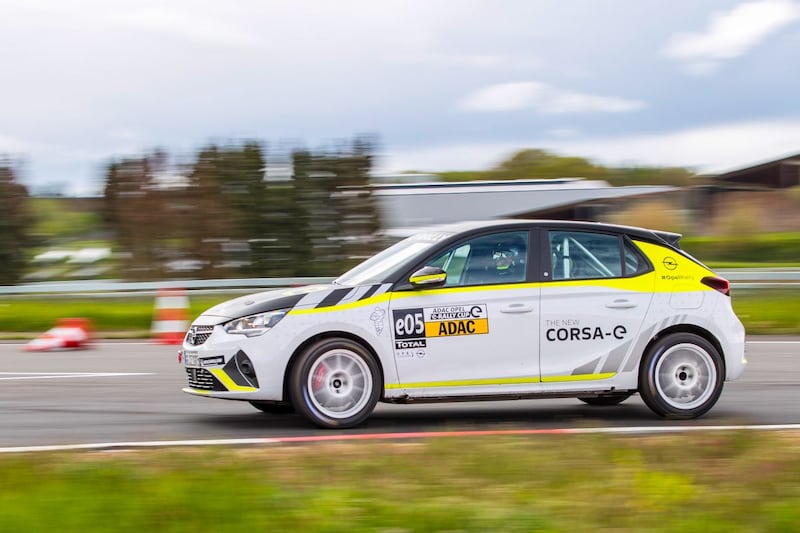
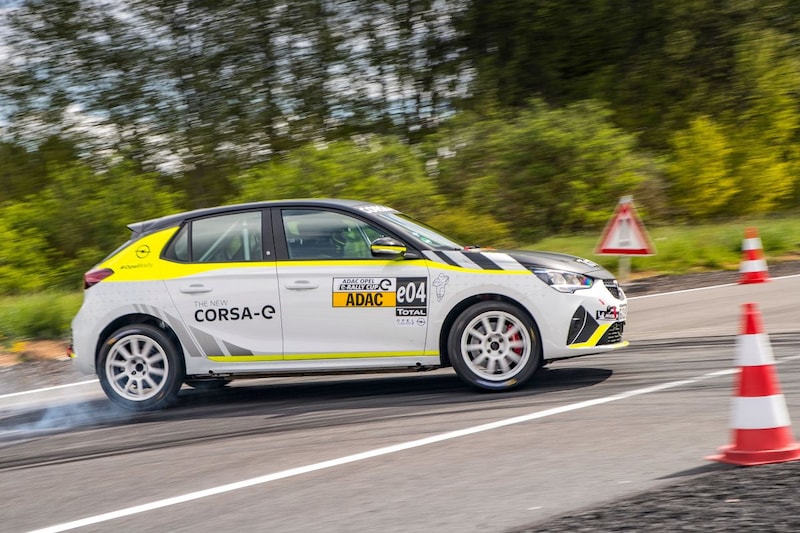
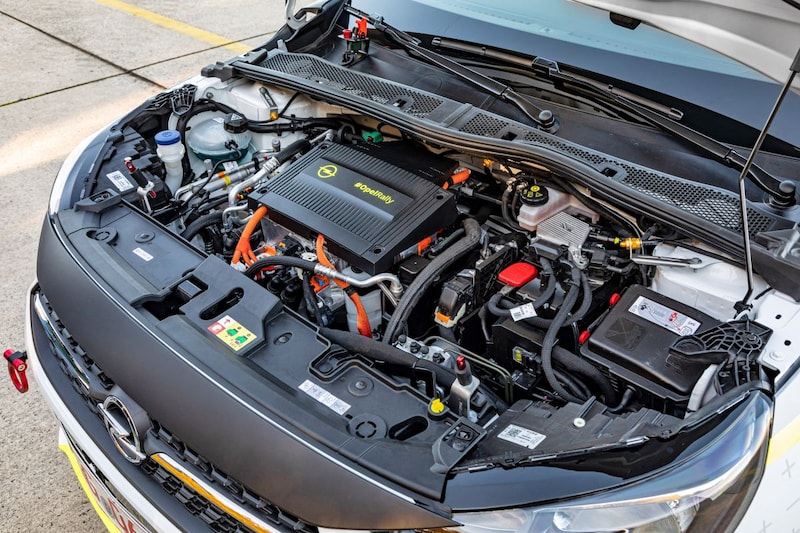
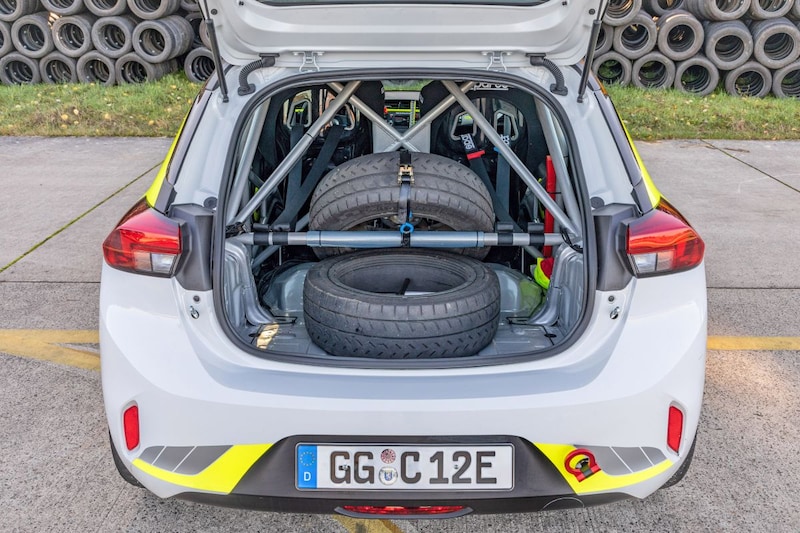

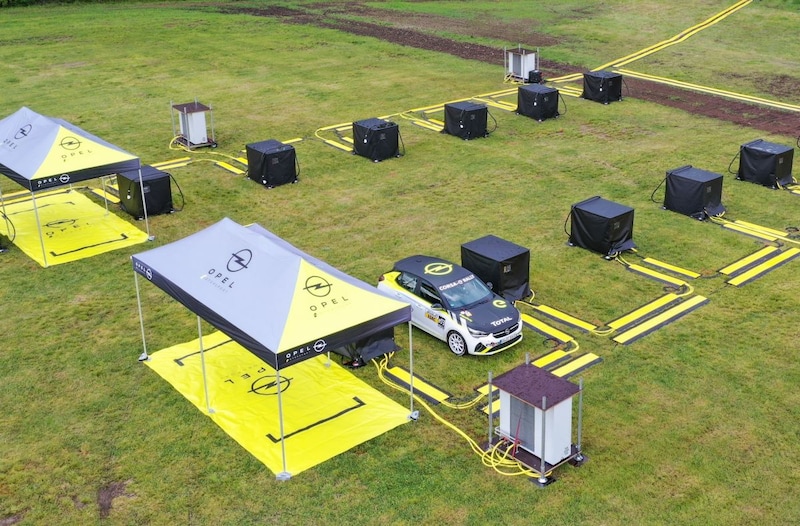


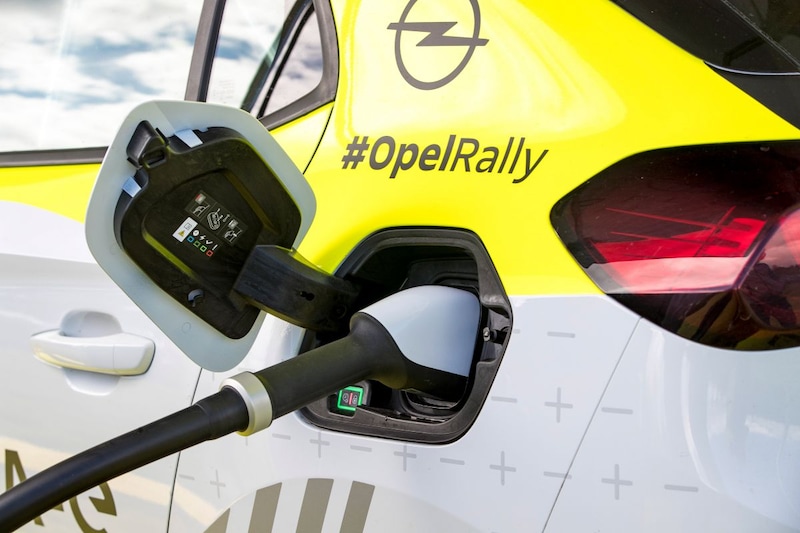
Can you combine a long tradition in rallying with a brand strategy that should lead to an electrified version of each model within three years? Well, if it’s up to Opel. Meet the fully electric Corsa-e Rally, which makes its debut on the German rally tracks this month and steers remarkably well thanks to 300 kilograms of battery weight.
I have to dig deep into my memory to explain the déjà vu feeling. How do I recognize those grass-covered hangars? Then I realize I’ve been to this former military airbase before; 20 years ago, to be exact. In the early summer of 2001, I was also here at the invitation of Opel, as one of the lucky few to try the amazing Astra X-Treme. As the enthusiast will recall, that 444 horsepower, carbon-constructed über-Astra was derived directly from Opel’s DTM cannon of yore, and made street legal with minimal modifications. It was a rather contrived attempt to link sporting activities to everyday cars; the X-Treme really had nothing to do with an ordinary Astra. A pure ‘halo car’, but an extremely fun one! It’s a shame that the plan to build a small series of these never went through. In 2021, Pferdsfeld Airport, just under a hundred kilometers west of Frankfurt, has been transformed into a state-of-the-art test track. So it’s no surprise that the penny didn’t drop right away. Another difference is that today I won’t be driving a crazy, wildly roaring one-off, but an electric rally car that shares many genes with the street version on which it is based. Other times.
Critical Adjustments
What has not changed are the cheerful blue eyes of Volker Strycek who welcome me. “You’re going to like this too,” says the man who became DTM champion in 1984 with a BMW 635 CSi and has held leadership positions at OPC and Opel Motorsport since the mid-1990s. He may have read my mind. The regular Corsa-e is by no means a stirring tearing iron. Even its torque and the resulting acceleration from 0 to 100 km/h in 8.1 seconds are hardly challenging; if you press the right pedal too enthusiastically, you will be confronted with an over-enthusiastic nose sniffing. No, the pleasantly steering, comfortable Corsa-e is above all a (excellent) rational choice for those in the market for a relatively affordable EV.

Especially when it is winding, you will have a great time here.
Just because the Corsa-e Rally is the same in many ways, doesn’t necessarily mean it’s going to be a boring ride. Enough crucial changes have been made to turn it into a machine for young talents to learn the rally business (see box). The motor and 50 kWh battery pack have been left untouched, but a new ‘cooling strategy’ has been developed, controlled by a separate control unit. “Even at 30 degrees outside and full load, the output remains constant for at least 30 kilometers, enough for any special stage,” assures Strycek. In theory, the body is also the same, although the necessary reinforcements have been applied and a number of lighter body parts have been mounted. Of course the interior has been stripped and equipped with a roll cage and racing fairings. The most important changes, however, are under the skin. The Rally has a serious sports suspension, suspended at the front in uniballs and equipped with robust Bilstein dampers all around. Camber, track and carriage height are adjustable. Finally, special attention is paid to safety. For example, an extra 5 millimeter thick aluminum protective plate has been mounted under the battery pack and red hazard lights come on both on the outside and inside if there is a problem with the high-voltage system. In the event of a crash, the car switches itself off within a second.

Bilstein dampers and Eibach springs give a lot of grip and control.
starship troopers
The Opel guys have done their best to build an attractive rally course for a few kilometers, with barriers to maneuver around, short chicanes and some jagged 180-degree turns where you can try the fly-off handbrake – an indispensable part of a rally car. The first thing you notice during the reconnaissance lap is the loud, artificial sound. It is somewhere between a spaceship and a rim that rolls, and is shouted into the world through maritime, water-resistant speakers. It was a safety requirement of the German Motorsport Association: spectators must be able to hear the car coming during the test. The advantage for the driver is that you can hear when you have wheelspin. Nevertheless, I turn off the rather dominant sound, something that is only allowed during the connecting stages in a rally. The relative silence that follows is just as crazy, because you are not used to that in a racing or rally car. So does the excessive noise that suddenly enters the uninsulated cockpit – tire noise, pebbles in the wheel arches, grinding brakes, that sort of thing. I also have to suppress the (circuit) tendency to switch back for every bend, after all, this Corsa has no gearbox.
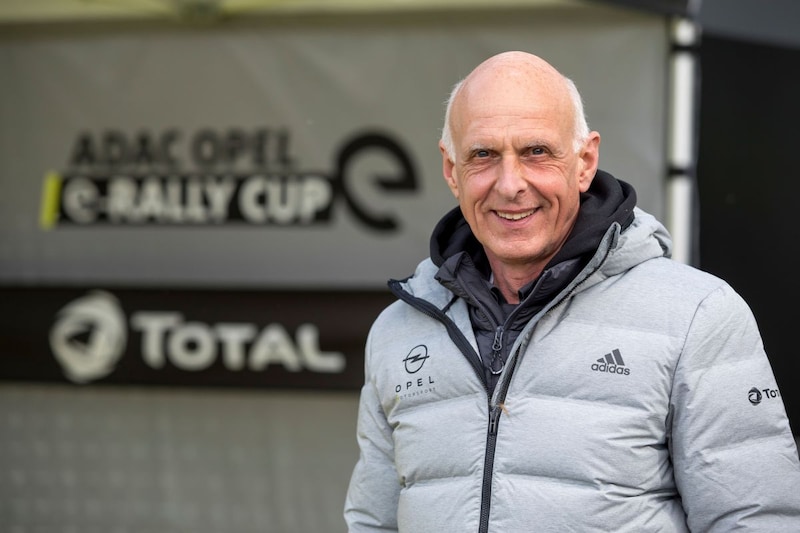
Volker Strycek once raced in fire-breathing DTM cars, now he has devoted himself to helping develop the Corsa-e Rally.
Dosable power pedal
Striking is the dosability of the delicious torque of 260 Nm, which is not curbed by ESP or traction control. “We put a lot of work into programming the throttle response,” Volker Strycek tells me afterwards. “The aim was to build up the forces as linearly as possible.” Add to this the Torsen differential lock and the 200 millimeter wide Michelin rally rubber, and the grip and control out of the corner are phenomenal. Slightly more or less throttle immediately results in a slight change of direction from the nose, although the suspension and damping (as usual with a rally car) are not smashing hard; after all, the undercarriage must have sufficient ‘travel’ to absorb potholes and bumps. The main question, however, is how the car behaves in the bend, because that is where the most time is gained or lost. No matter how good a navigator’s pace notes are, on a rally stage there is always a certain unfamiliarity with the course and the conditions from corner to corner. So it is important to have confidence in your car. “Normally, on a compact front-wheel drive, it is difficult to get the rear tires warm,” said Strycek. “Thanks to the battery mounted low between the two axles, the weight of the Cora-e is much more evenly distributed than a comparable petrol car. This means you don’t have to worry about ‘snap upset’ and you can push right at the start of a test. By the way, on clay you notice how nice the balance is.”

Motor and battery are taken directly from the regular Corsa-e
In higher rally spheres
Also on the asphalt and concrete of Pferdsfeld I feel exactly what Opel’s sports legend means, especially when my wet tires are exchanged for slicks. The track is still damp here and there, nevertheless the rubber warms up within half a lap and I can look for the limit when turning in. That has to be done with any policy. The car weight of 1.475 kilograms (of which 300 kg for the battery) cannot be brushed away just like that, no matter how nicely it is distributed and how well the non-powered Brembo’s are also calculated for their task. If you go into the anchors too late, the nose will inexorably slide straight ahead. If, on the other hand, you start a little earlier and send in with a fraction of the brake pressure, especially with longer bends, the rear is wonderfully controllable to ‘put’ a bit. At shorter angles I use the handbrake to flip the butt. A short, firm jerk is enough, otherwise the tires will eat into the asphalt and you will lose too much speed. Long straights are an annoying break from this exercise; above 100 km/h there is not enough energy in the 136 hp engine to keep the adrenaline up. But as soon as another series of corners presents itself, you immediately return to higher (rally) atmospheres. The Opel Corsa-e Rally will give many young drivers a lot of fun.

Of course, the carriage is equipped with a roll cage.
Mobile charging station with 2,000 kW
Opel has put a lot of effort into the charging infrastructure. It was one of the main challenges of the project. After all, rally cars are in action for a long time, with about six to eight special stages (KPs) per day and many connectors. At full load, the range of the Corsa-e Rally is only about 60 kilometers, so frequent refueling is required. That is why a charging station is built on the paddock at every rally. “We just get power from the public network, even if we’re standing in a meadow somewhere, connection is never far away,” says an employee of eLoaded, the company responsible for the infrastructure. “Thanks to a total capacity of 2,000 kW, eighteen cars can easily charge at the same time. Each charging point can supply 280 kWh, but because the Corsa-e feeds with a maximum of 100 kWh, we have limited that to 120 kWh. The batteries are about 80 percent full again in about half an hour, so the race schedule has been set up in such a way that the Corsas enter the service park first and are the last to leave.” He adds that green energy is purchased for every event. Of course, a large, mobile transformer is needed for the conversion from AC to DC. “And we are installing four water coolers. In total we have two trucks with equipment, with four people we build the charging park in one day.” It all sounds great, but you don’t always come up with the range, especially at rallies where two or three longer special stages are run in succession. “Sometimes the Corsas therefore have a slightly shorter program than the other participants and, for example, they only drive fifteen of the twenty tests and extra stops are planned.”

Mobile charging station.
Young talent first
After an illustrious period in the DTM (1988-2005), the focus of Opel Motorsport has returned to rally driving for a decade and a half, the sport in which the brand caused a furore in the 1980s – culminating in the world title of Walter Röhrl and his transverse Ascona 400 (1982). In the new millennium, Opel is mainly focusing on recreational sports. In recent years, various Astras, Corsas and Adams have been developed for different categories. Talent promotion is a top priority. Since the start of the ADAC Opel Rallye Cup in 2013, 94 young drivers from 18 countries have taken part. The best advanced to the Opel Rallye Junior Team. As of this season, the entry-level class is called Opel e-Rally Cup and identical electric Corsas will be driven, as can be seen on these pages. They are delivered ready-made for €49,900 and run by private teams. Thanks to the maintenance-friendly powertrain, the latter costs about half of the former Adam Cup. Within each team, at least one person must obtain a certificate to be allowed to work on the electrical systems of the Corsa-e. The Opel e-Rally Cup will be in action this year in six German and one Czech rallies, starting on June 11 and 12 at the ADAC Rallye Stemweder Berg.

dthis article originally appeared in Techzle 22, 2021.